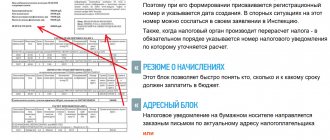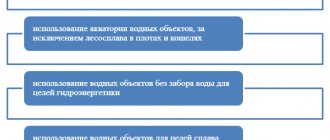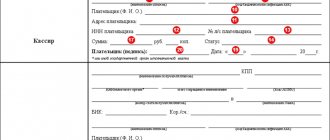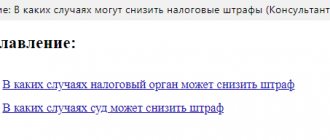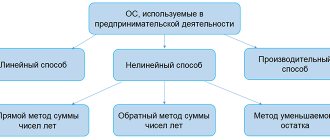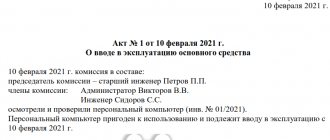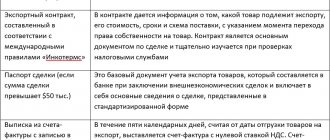Regulatory regulation
Article 126 of the Tax Code of the Russian Federation provides for fines for failure to provide documents and information to the tax authority.
BOO. Tax sanctions are reflected in account 99.09 “Other profits and losses” (Instructions for using the Chart of Accounts, approved by Order of the Ministry of Finance dated October 31, 2000 N 94n, clause 83 of the Accounting Regulations, approved by Order of the Ministry of Finance dated July 29, 1998 N 34n, Letter of the Ministry of Finance dated February 15, 2006 N 07-05-06/31, Chart of Accounts 1C).
There are recommendations from the Ministry of Finance of the Russian Federation to reflect sanctions for violation of tax laws as part of other expenses (Letter of the Ministry of Finance dated December 28, 2016 N 07-04-09/78875, clause 11 of PBU 10/99).
The organization should fix the way these expenses are reflected in its accounting policies.
WELL. The amounts of sanctions for violation of tax laws are not taken into account in expenses (clause 2 of article 270 of the Tax Code of the Russian Federation).
USN. Tax fines are also not taken into account when calculating tax, since they are not included in the closed list (Article 346.16 of the Tax Code of the Russian Federation).
Accounting in 1C
On April 15, the Organization received a demand to pay a fine of 200 rubles. in accordance with paragraph 1 of Art. 126 of the Tax Code of the Russian Federation for failure to provide an explanatory note to the financial statements.
On the same day, the fine was paid to the budget.
Calculation of a fine
Document the calculation of the fine using the document Operation entered manually in the Operations section - Operations entered manually.
Please indicate:
- Debit - 99.09 “Other profits and losses”;
- Credit - 68.10 “Other taxes and fees”; Subconto 1 - type of payment to the budget Fine: accrued/paid ;
- Subconto 2 - budget levels Local budget .
BukhExpert8 recommends using account 68.10 “Other taxes and fees” to correctly fill out a payment order in the program.
Creating a payment order
Generate a payment order to pay a fine to the budget using the Payment order in the Bank and cash desk - Payment orders section. In this case, you must correctly indicate the Type of transaction - Payment of tax . Then the form of the document takes the form for payment of payments to the budget system of the Russian Federation.
You can also quickly generate a payment order using the Tax Payment Assistant through the Bank and Cashier section - Payment orders by clicking the Pay button - Accrued taxes and contributions.
Some of the data will be filled in automatically. Please pay attention to filling out the fields:
- Tax - Other taxes and fees , selected from the Taxes and Fees directory;
- Type of obligation - Fine ;
- Priority of payment - 5 Other payments (including taxes and contributions) (clause 2 of Article 855 of the Civil Code of the Russian Federation) ;
- The recipient is the Federal Tax Service, to which tax penalties are paid, selected from the Counterparties directory;
- Recipient's account - bank details of the tax authority specified in the Recipient .
Check the data at the link Details of payment to the budget (clauses 7 - 10 of Appendix No. 2 to Order of the Ministry of Finance dated November 12, 2013 N 107n, Letter of the Federal Tax Service dated September 20, 2021 N KCH-4-8 / [email protected] ).
Please indicate:
- KBK - 18211603010016000140 “Monetary penalties (fines) ...”;
- OKTMO code is the code of the territory in which the Organization is registered. The value is filled in automatically from the Organization ;
- Payer status - 01-taxpayer (payer of fees) - legal entity ;
- UIN - The UIN specified in the tax notice or request for payment of tax (penalties, fines) is not indicated in our example, therefore 0 ;
- Basis of payment - ZZ - repayment of debt for expired tax periods, including voluntary ;
- Tax period - Payment on a specific date ;
- Date —the deadline for paying the fine upon request;
- Document number and Document date - number and date of the requirement;
- Purpose of payment - filled in automatically using a template from the Taxes and Contributions directory. The field can be edited if necessary.
Payment of the fine
After paying penalties to the budget, based on the bank statement, you need to create a document Write-off from the current account transaction type Payment of tax . A document can be created based on a Payment Order using the link Enter document debited from current account . PDF Basic data will be transferred from the Payment order .
It can also be downloaded from the Client-Bank program or directly from the bank if the 1C: DirectBank service is connected.
Check that the fields in the document are filled in:
- Date – date of payment of the fine, according to the bank statement;
- According to document No. from - the number and date of the payment order;
- Tax - Other taxes and fees , selected from the Taxes and Fees directory;
- Type of obligation - Fine ;
- follow the link Reflection in accounting : Debit account - 68.10 “Other taxes and fees”;
- Types of payments to the budget - Fine: accrued/paid ;
- Budget levels - Local budget .
Postings
The document generates the posting:
- Dt 68.10 Kt - payment of a fine to the budget.
We reflect penalties and fines on taxes in accounting and reporting
Accountant
What to do Review / October 2014 #10 (118)
21893
Penalties and fines are not the same thing
One of the grounds for the accrual of penalties and fines is the taxpayer’s failure to fulfill the obligation to pay tax or its fulfillment at a later date.
The reasons for poor performance of these duties may vary. These are errors in accounting entries, incorrect determination of the tax base, use of the wrong tax rate, incorrect application of tax benefits, incorrect application of tax deductions, and even simple technical errors when filling out the declaration. An error in tax calculation can be detected by the taxpayer himself. In this case, if an underestimated amount of tax is detected, he independently pays the missing amount of tax and the corresponding penalties, and then submits an updated declaration to the tax office. But there may be another option. The fact of misrepresentation of information, which led to failure to fulfill the obligation to pay tax in whole or in part, is identified by the tax authority. As a result, the taxpayer receives a decision from the tax authority based on the results of consideration of the tax audit materials (a decision to bring to tax liability or a decision to refuse to bring to tax liability) and a requirement to pay tax arrears, penalties and fines. Regardless of the error detection option, the mechanism for calculating penalties is the same. Penalties are accrued for each calendar day of delay in fulfilling the obligation to pay a tax or fee, starting from the payment day following the payment day established by the legislation on taxes and fees. The interest rate of penalties is assumed to be equal to 1/300 of the Bank of Russia refinancing rate in force on these days. Penalties are calculated separately for each period of validity of a specific rate during the debt period, and the results obtained are then added up. And if penalties are a way of ensuring the fulfillment of the obligation to pay taxes and fees1, then a fine is already a tax sanction in the form of a monetary penalty, which is a measure of the taxpayer’s responsibility for committing a tax offense2. The fine for non-payment or incomplete payment of tax may be 20% of the unpaid amount of tax (fee), and if there is intent - 40%3. Both fines and penalties subject to transfer to the budget are not taken into account when determining the tax base for corporate income tax4. Methods of reflecting penalties and fines in accounting
Since the legislation on taxes and fees distinguishes between the concepts of “penalty” and “fine,” the methods of reflecting them in accounting may be different.
Fines for violation of tax laws in accounting are reflected in the debit of account 99 “Profits and losses” in correspondence with account 68 “Calculations for taxes and fees”. This is directly provided for in clause 83 of the Regulations on Accounting and Financial Reporting5 and the Instructions for the Application of the Chart of Accounts, which clearly states that account 99 “Profits and Losses” during the reporting year reflects “also the amounts of tax sanctions due in correspondence with the account 68 “Calculations for taxes and fees.” The Ministry of Finance of Russia gives similar explanations6. There are two positions regarding the reflection in accounting of penalties subject to transfer to the budget. In the first case, experts follow the path of simplifying accounting. They combine penalties and fines with the term “sanctions for non-compliance with tax rules” and propose to take them into account in the same way as fines, i.e. by debiting account 99 “Profits and losses” in correspondence with account 68 “Calculations for taxes and fees”. With this accounting method, the analyst is asked to maintain accounts 68 in subaccounts in the context of taxes for which penalties and fines are accrued. Another position of experts is that the amounts of penalties for arrears of taxes satisfy the definition of an expense. After all, the accrual of penalties leads to the creation of an obligation for the organization and a decrease in its capital7. This expense is not an expense for ordinary activities, therefore it is classified as “other”8. And they propose to reflect the amounts of accrued penalties on the debit of account 91 “Other income and expenses”, subaccount 91-2 “Other expenses” in correspondence with account 68 “Calculations for taxes and fees”. Due to the presence of several acceptable ways of reflecting penalties in accounting, one of them must be fixed in the accounting policy of the organization9. Penalties - other expenses
Let's consider the algorithms for the taxpayer's actions when reflecting penalties and fines when an error leading to non-payment of tax is discovered by him independently or it is revealed as a result of a tax audit.
In the examples, we assume that the organization reflects penalties as other expenses. Option 1.
The taxpayer himself discovered an error that led to non-payment of tax.
Step 1.
Identify the error in tax payment.
We determine the missing tax amount. The procedure for correcting errors in accounting is regulated by the Accounting Regulations “Correcting Errors in Accounting and Reporting”10, approved by Order of the Ministry of Finance of Russia dated June 28, 2010 No. 63n11. We calculate penalties for each day of delay as a percentage of the unpaid tax amount. #ATTENTION# We prepare the calculation using an accounting certificate. There is no unified form for this document. Therefore, the company needs to develop such a form itself and indicate it in its accounting policies. We reflect transactions for additional tax assessment and the amount of penalties for late payment in accounting (entries for additional tax assessment and correction of errors in accounting are not given in the article). Penalties are recognized as other expenses in accounting. Since they are not taken into account in expenses for profit tax purposes, an organization applying PBU 18/02 must recognize a permanent difference in the amount of penalties and at the same time reflect a permanent tax liability as the product of this constant difference by the established income tax rate12. Step 2. We pay the arrears of tax and the amount of penalties. Step 3.
Submit an updated tax return to the tax office. An explanatory letter and copies of payment orders for payment of taxes and penalties should be attached to the “clarification”. An organization is exempt from liability if it submits an updated declaration after the deadline for filing it and paying the tax has expired, if the missing amount of tax and the corresponding penalties were paid before submitting the updated tax return13.
| Contents of operations | Debit | Credit | Primary document |
| The amount of the penalty is reflected | 91-2 | 68, subaccount “Tax penalties” | Accounting certificate-calculation |
| The permanent tax liability is reflected (amount of penalties x 20%) | 99 | 68, subaccount “Income Tax” | Accounting certificate-calculation |
| Penalties paid to the budget | 68, subaccount “Tax penalties” | 51 | Bank statement on current account |
Option 2.
The tax authority discovered the fact of incomplete payment of tax based on the results of a tax audit. In accounting, the basis for reflecting the amount of arrears, penalties and fines based on the results of a tax audit is the decision of the tax authority.
It already contains information about the amount of tax debt, the amount of penalties and fines. The penalties specified in the decision of the tax authority are calculated at the time of its adoption. In the future, when sending a request to the taxpayer for payment of taxes, penalties and fines, the amount of the penalty will be recalculated on the day the demand was sent14 or on the day the arrears were paid. The decision of the tax authority comes into force one month from the date of its delivery15. At the same time, the taxpayer has the right to voluntarily comply with this decision before it comes into force. Basis: para. 3 clause 9 art. 101 Tax Code of the Russian Federation. Moreover, this decision can be executed in whole or in part. If the taxpayer does not intend to appeal this decision at all or will appeal it in some part, then it is better for him to pay the arrears (the corresponding part of the arrears) as early as possible in order to reduce the amount of the penalty. However, in this case, an overpayment will be recorded in the taxpayer’s personal account, which will be closed after the Tax Authority’s Decision comes into force. Let's consider a situation where the taxpayer does not appeal the decision of the tax authority. Step 1.
We reflect in the accounting records the amount of arrears and fines at the time of receiving the decision of the tax authority.
The amount of the fine is recognized as a loss in accounting. Step 2.
We pay the tax arrears based on the decision of the tax authority.
Step 3.
We reflect in the accounting records the amount of penalties as of the date of repayment of the arrears.
We “add additional” penalties to ourselves for the period from the date of the Decision on the inspection report to the date of payment of the arrears and add this amount to the amount of penalties specified in the Decision. We calculate “additional” penalties in the accountant’s certificate. Penalties are recognized as other expenses in accounting. Step 4.
Pay penalties and fines. There is no need to rush into paying them. In order not to withdraw funds from circulation ahead of time, penalties and fines can be paid after the Decision on the inspection report comes into force within the time limits established in the Request for payment of penalties and fines.
| Contents of operations | Debit | Credit | Primary document |
| The amount of the fine is reflected | 99 “Profits and losses”, subaccount “Tax fines” | 68 | Tax authority decision |
| The amount of penalties for tax arrears is reflected | 91-2, subaccount “Tax penalties” | 68 | Decision of the tax authority Accounting certificate-calculation |
| The permanent tax liability is reflected (amount of penalties x 20%) | 99 | 68, subaccount “Income Tax” | Accounting certificate-calculation |
| Penalties and fines have been paid to the budget | 68 | 51 | Bank statement on current account |
Please note
that if errors are identified by the tax authority, the organization does not need to provide updated declarations for past periods based on the decision made based on the results of the audit16.
We reflect the amounts of penalties and fines in the financial statements
In the accounting option, when accrued penalties are recognized by the organization as another expense and reflected in subaccount 91-2, in the Financial Results Report (form approved by Order of the Ministry of Finance of Russia dated July 2, 2010 No. 66n), the amount of penalties will be included to the indicator of line 2350 “Other expenses” and reduce the indicators of line 2300 “Profit (loss) before tax”.
In this case, the permanent tax liability accrued on the amount of penalties and reflected on line 2421 will affect the amount of the current income tax and the indicator on line 2400 “Net profit”. Fragment of the form Report on financial results
#FOOTNOTE#
| Explanations | Indicator name | Code | For ______ 20__ | For ______ 20__ |
| 1 | 2 | 3 | 4 | 5 |
| other expenses | 2350 | ( ) | ( ) | |
| Profit (loss) before tax | 2300 | |||
| Current income tax | 2410 | ( ) | ( ) | |
| incl. permanent tax liabilities (assets) | 2421 | |||
| Change in deferred tax liabilities | 2430 | |||
| Change in deferred tax assets | 2450 | |||
| Other | 2460 | |||
| Net income (loss) | 2400 |
In the accounting option, when the amount of penalties and fines payable to the budget is reflected in the debit of account 99, in the Statement of Financial Results this amount will be indicated on line 2460 “Other” and will reduce the indicator on line 2400 “Net profit”.
The advantage of this method of reflecting penalties is that the interested user analyzing the statements will receive information about the formed indicator of profit (loss) before tax without taking them into account. However, in each of the considered options, the value of the “Net profit (loss)” indicator will not change. Which option for accounting for penalties and fines an accountant should follow depends on the organization’s accounting setup, the type of accounting programs used, the requirements of internal audit, and other things. However, something else is important. The presence of tax sanctions on an organization leads to a deterioration in its financial condition, and therefore it is necessary to take all measures to prevent them. Share
Tweet
Certificate of registration of media: El No. FS77-67462 dated October 18, 2016 Editorial contacts,
On this topic
Let's take the blow, or Instructions for an accountant on working during the period of sanctions 91 List of anti-sanctions measures 2022 132 Which cost item should include personnel training 68

